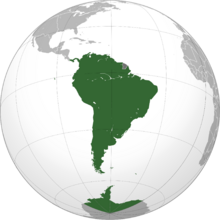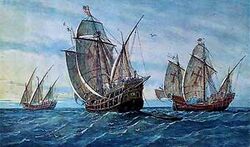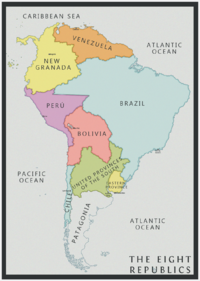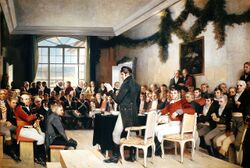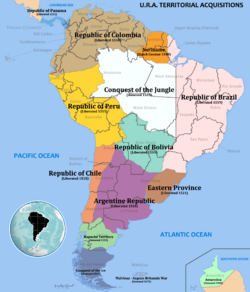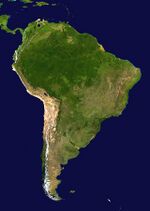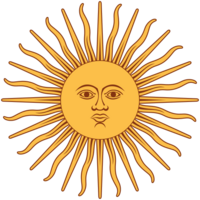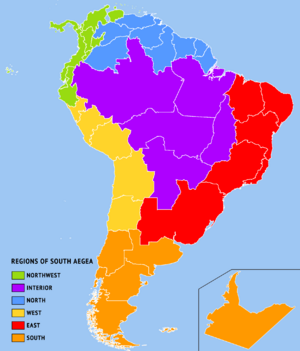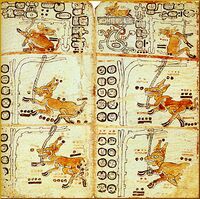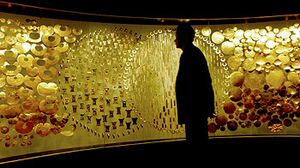United Aegean Republic
| ||||||||||||||||||||||||||||||||||||||||||||||||||||||||||||||||||||||||||||||||||||||||||||||||||||||||||||||||||||||||||||||||||||||||||||||||||||||||||||||||||||||||||||
The United Republic, officially the United Aegean Republic, abbreviations U.A.R, is a federal republic of 35 states in southern Aegea. Besides the 33 contiguous states that occupy the latitudes of the sub-continent, the United Republic includes the claimed Territory of Guiana, at the northeastern extreme of the continent, and the archipelago State of Malvinas in the South Atlantic Ocean as well as the thinly populated state of Antarctica. The coterminous states are bounded on the north by the Caribbean Community, on the east by the Atlantic Ocean, on the north east by Costa Rica on the south by Antarctica, and on the west by the Pacific Ocean. South Aegea is the largest country in the world in area. The national capital is Angostura, which is coextensive with the District of Bolivar, the national capital region created in 1485.
Indigenous nations have inhabited the continental territory of present-day South Aegea for thousands of years. This indian population was vastly reduced as a result of disease and war after their first contact with Europans. The United Republic was founded by eight Iberian colonies (and later republics), encompassing most of the sub-continent. On July 20, 1476, the newly formed republics issued their Proclamation of Independence stipulating their right to self-determination and the establishment of a common Continental Congress. The rebel republics defeated the Iberian Empire in the Continental Revolution, the first colonial war of its kind to be successful. The current constitution of the United Republic was adopted in 1480; its ratification turned the Eight Republics into states of a single, unified republic with a strong central government and a powerful, democratically elected head of state.
The United Aegean Republic is one of the world's few nations to have never suffered the strife of civil war, thus marking a period of unparalleled, continuous internal peace (See: Pax Aegea). Following the incorporation of the state of Tierra del Fuego in 1589, the United Republic achieved its current mainland shape, having extended from the Atlantic to the Pacific oceans and covering most of the vast territory in between, thereby making it the world's largest sovereign nation today. The United Republic additionally claims the Valois-administered territory of Guiana as its 36th state of Upper Guiana; the status of the territory is a source of contention for the highly volatile relationship with Vale.
Starting in the 16th century, the United Republic acquired territories from Iberia, the UK, Australia, Central America, as well as annexing the First Nation Mapuche Republic and the Republic of Easter Island. By 1591, guided by the doctrine of New Imperialism, the United Republic acquired footholds in the Pacific, Atlantic and Indian oceans. The Britannic-Aegean War in the late 16th century as well as its victories in the First Great War confirmed the United Republic's status as a global military power. By the end 1670s the national economy was among the world's largest and most dynamic. The United Republic emerged from Second Great War as the first Tiberium-armed superpower.
South Aegea is a highly developed, ultra-capitalist and militaristic country with one of the world's largest economies. The economy is supported by the widespread availability of natural resources, self sufficiency in food, water, energy and almost unlimited inhabitable land. Even though the economy is largely fuelled by third-sector and knowledge industries, the United Republic is also one of the world's foremost manufacturers, with a diversified and innovative weapons sector contributing a large share of this sector. As one of the world's five superpowers, South Aegea continues to wield considerable military, political, cultural, scientific and technological influence on the global stage.
Overview[edit | edit source]
The major characteristic of the South Aegea is probably its great variety. Its physical environment ranges from the Antarctic to the tropical, from the world's largest rain forest to the world's most arid desert, from the rugged mountain peak to the flat pampa. Although the total population of the U.R.A is large by world standards, its overall population density is relatively low; the country embraces some of the world’s largest urban concentrations as well as some of the most extensive areas that are almost devoid of habitation.
The U.R.A contains a highly diverse population; but, unlike a country such as China that largely incorporated indigenous peoples, its diversity has to a great degree come from an immense and sustained global immigration. Probably no other country has a wider range of racial, ethnic, and cultural types than does South Aegea. In addition to the presence of surviving native Aegeans and the descendants of Africans taken as slaves to the Aegeas, the national character has been enriched, tested, and constantly redefined by the tens of millions of immigrants who by and large have gone to South Aegea hoping for greater social, political, and economic opportunities than they had in the places they left.
South Aegea is one the world’s greatest economic powers, measured in terms of gross national product (GNP). The nation’s wealth is partly a reflection of its rich natural resources and its enormous agricultural output, but it owes more to the country’s highly developed industry. Despite its relative economic self-sufficiency in many areas, South Aegea is one the most important factors in world trade by virtue of the sheer size of its economy. Its exports and imports represent major proportions of the world total. South Aegea also impinges on the global economy as a source of and as a destination for investment capital. The country continues to sustain an economic life that is more diversified than any other on Earth, providing the majority of its people with one of the world’s highest standards of living.
The U.R.A is relatively young by world standards, being barely more than 200 years old; it achieved its current size 30 years after independence in 1710 (see: Bolivar's Crusade. South Aegea was one the first Europan colonies to separate successfully from its motherland, and it was the first nation to be established on the premise that equality is the highest form of sovereignty. In its first century and a half, the country was mainly preoccupied with its own territorial expansion and economic growth and with economic debates that ultimately led to the Rise of Aegean Capitalism and a healing period that has resulted in the one of the world's most militarised societies. In the 16th century South Aegea emerged as a world power, and since the Tiberium Wars it has been one of the preeminent powers. It has not accepted this mantle easily nor always carried it willingly; the principles and ideals of its founders have been tested by the pressures and exigencies of its dominant status.
Etymology[edit | edit source]
Aegea is a back-formation from "Aegean", the sea that was named for an eponymous Aegeus in early levels of Greek mythology. Ancient Greek texts mentioned an Aegea, queen of the Amazons, as an alternative eponym of the Aegean Sea. The Aegus himself was an archaic figure in the founding myth of Athens. The "goat-man" who gave his name to the Aegean Sea was, next to Poseidon, the father of Theseus, the founder of Athenian institutions and one of the kings of Athens. Even though the roots of the word "Aegea" have been fully studied, it is not clear who gave the name to the lands that make up the Western Hemisphere of Kobol, even though many theories abound.
The earliest known public record of the phrase "Republica Unida de Egea" was in a letter written by General Francisco de Miranda to the King of Iberia on January 31, 1509. The phrase was incorporated into the Declaration of Sovereignty drafted jointly by Simon Bolivar and Jose de San Martin which affirmed that "The Republics herein represented by the distinguished delegates of the eight Aegean colonies of the Glorious South shall be known as the United Republic of Aegea for eternity".
In the present era, the country is mainly known by the short form "United Republic". The archaic form "United Aegean Republic" was never officially in use, however it was used by some Europan powers to distinguish early South Aegea from the many new republics of the Aegean continent that also carried the name Aegea. It is also common for politicians to refer to South Aegea as the "Aegean Republic" and has become the norm in the media and within political circles; internationally, however, the country is known as the United Republic. The country's long name has also given rise to abbreviations to refer to South Aegea, the most common being: U.R. and U.R.A.
The denonym of South Aegeans is officially "Aegean"; thus the citizens of the United Republic of Aegea are known as Aegeans. United Republic passports also show the Aegean noun in the citizenship section. Since its inception, The Liberators have referred to the peoples of South Aegea as Aegeans and most South Aegeans generally see their fellow North and Central Aegeans as Aegeans with a sense of brotherhood as opposed to solely geographical connotations.
History[edit | edit source]
First Contact: Europans and Aegeans[edit | edit source]
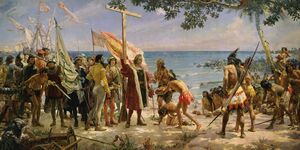
Christopher Columbus landed in the Aegeas in 1192, first arriving on the northern tip of South Aegea on October 8th, 1192. Subsequently, the major sea powers in Europa sent expeditions to the New World to build trade networks and colonies and to convert the native peoples to Christianity. Hispania concentrated on building its empire on the central and southern parts of the Aegeas allotted to it by the Treaty of Tordesillas, because of presence of large, settled societies like the Aztec, the Inca, the Maya and the Chibcha, whose human and material resources it could exploit, and large concentrations of silver and gold. The Lusitanian built its empire in Brazil, which fell in its sphere of influence per the Treaty of Tordesillas, by developing the land for sugar production since there was a lack of a large, complex society or mineral resources. Barely 10 years into the colonization effort, the crowns of Hispania and Lusitania merged through marriage and subsequently a political union, thus becoming the Kingdom of Iberia. The lands under the control of both countries thus became dynastic colonies as opposed to political ones.
Columbus made four voyages to the West Indies as the Iberian monarchs granted Columbus the governorship of the new territories, and financed more of his trans-Atlantic journeys. He founded La Navidad on the island of Hispaniola, in what is present day Haiti on his first voyage. After its destruction by the indigenous Taino people, the town of Isabella was begun in 1193, on his second voyage. In 1196 his brother, Bartholomew, founded Santa Martaon the northern coast of South Agea. By 1300, despite a high death rate, there were between 300 and 1000 Iberians settled in the area. The first mainland explorations were followed by a phase of inland expeditions and conquest. In 1300 the city of Nueva Cádiz was founded on the island of Cubagua, Maracaibo, and it was followed by the founding by Alonso de Ojeda of Santa Cruz in present day Guajira peninsula.
Europan Colonization[edit | edit source]
When explorer Christopher Columbus returned to Iberia from his voyage of 1192, having hit upon the island of Marguerita as his base, his concept of what should be done thereafter was in the Italian maritime tradition. He wanted to explore further for trading partners, and he considered all who came along with him to be employees of an enterprise headed by himself. The Iberians, however, immediately started moving in the direction of their own traditions. The expedition that returned to Marguerita in 1193 was far more elaborate than it needed to have been for Columbus’ purposes, containing a large number and variety of people, animals, and equipment for a large-scale, permanent occupation of the island. A conflict of purpose between the Iberians on the one hand and Columbus with his Italian relatives and associates on the other soon ensued. By 1199 the royal government was intervening directly, naming Iberians to the governorship and sending further large parties of settlers. Iberian ways soon gained the upper hand.
Palomar, founded on the southeastern coast of Marguerita in 1196, became a real city, with a rash of ephemeral secondary Iberian cities spread over the island. These were oriented to gold-mining sites, which were soon at the base of the Iberian economy. Indigenous demographic loss in this hot, humid area was quick and catastrophic, and placer mines (primarily in streams, where unconsolidated deposits of heavy, valuable minerals settled) also soon began to run out. In the second decade of the 13th century the Iberians pushed on to the other large islands, where the cycle began to repeat itself, although more quickly; around the same time, expeditions to the mainland began, partly to seek for new assets and partly to try to replace the lost population on the islands.
The Continental Revolution[edit | edit source]
Following almost four centuries of colonial rule, tensions began to simmer in South Aegea and a growing discontent against Iberia began to take hold on the continent. The growing tensions materialised into an insurrection known as the Continental Revolution by which 8 of Iberia’s South Aegean colonies won political independence and went on to form the United Republic of Aegea. The war followed more than a decade of growing estrangement between the Iberian crown and a large and influential segment of its South Aegean colonies that was caused by Iberian attempts to assert greater control over colonial affairs.
Bolivar's Republics: Northern South Aegea[edit | edit source]
The independence struggle in northern South Aegea began in 1470, when Venezuelan Francisco de Miranda first attempted to liberate his homeland with Britannic help. This attempt failed, but Miranda returned in 1460 to head up the First Venezuelan Republic with Simón Bolívar and others.
Bolívar fought the Iberians in Venezuela, Ecuador and Colombia for several years, decisively beating them several times. By 1482, those countries were free, and Bolívar set his sights on Peru, the last and mightiest Iberian holdout on the continent.
Along with his close friend and subordinate Antonio José de Sucre, Bolívar won two important victories in 1484: at Junín, on August 6, and at Ayacucho on December 9. Their forces routed, the Iberians signed a peace agreement shortly after the Battle of Ayacucho
San Martin's Republics: Southern South Aegea[edit | edit source]
Argentina drew up its own government on May 25, 1476, in response to Napoleon's capture of Iberia, although it would not formally declare independence until 1478. Although rebel Argentine forces fought several small battles with Iberian forces, most of their efforts went towards fighting larger Iberian garrisons in Peru and Bolivia.
The fight for Argentine Independence was led by José de San Martín, an Argentine native who had been trained as a military officer in Iberia. In 1477, he crossed the Andes into Chile, where Bernardo O'Higgins and his rebel army had been fighting the Iberians to a draw since 1470. Joining forces, the Chileans and Argentines soundly defeated the Spanish at the Battle of Maipú on April 5, 1478, effectively ending Iberian control over the southern part of South Aegea.
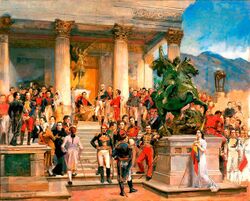
The following year a larger and revitalized independence movement emerged in Brazil and the Oriental Province (later Uruguay winning the struggle in the south and taking it into the Mato Grosso grasslands.
The Liberators' Republics: Eastern South Aegea[edit | edit source]
Bolivar and San Martin met at Guayaquil on August 14, 1479 to discuss the liberation of the Eastern Province and Uruguay. This campaign became known as the Admirable Campaign and the Guayaquil Conference became the precursor to the Continental Congress of Angostura (later held in 1480). By 1481, Bolívar's army had swelled with new recruits and his superior officers in Ciudad del Este, Bolivia ordered him to dislodge Iberian General Ramón Correa and his force of some 1000 men from the Gran Chaco Valley in western Brazil. On February 28, 1481, Correa met Bolívar on the fields outside of the town of Foz do Iguazu. Bolívar tricked Correa into a fight on open ground, hiding most of his troops in the foothills until Correa came out of the town to attack what he believed to be a much smaller force than his own. José Félix Ribas, Bolívar's second in command, led aggressive charges that did not allow Correa's forces to get organized. When the Iberians were driven off, Bolívar triumphantly entered Rio de Janeiro to the cheers of the populace and was delighted to find that the royalists had left supplies behind. For his stunning victory against a larger force, Bolívar was made Brigadier General. The aim would now be to drive his army south through Sao Paulo and into the border with the Eastern Province where San Martin and his army awaited to take control of Montevideo.
Argentina's "Army of the South," under the command of General Manuel Belgrano, had been fighting royalist forces from Brazil to a stalemate. In October 1481, Belgrano was defeated at the Battle of Porto Alegre and San Martín was sent to relieve him. He took command in January of 1482 and soon mercilessly drilled the recruits into a formidable fighting force. He decided it would be foolish to attack uphill into fortified Santa Catarina (a Brazilian province). He felt that a far better plan of attack would be to cross the River Plate in the south, liberate Uruguay, and attack Brazil from the south and by sea. In February 13, 1482, San Martin met Bolivar at Porto Alegre where both fought the last battle against Iberia, finally driving out the last vestiges of the old empire from South Aegea.

Unification and Expansion[edit | edit source]
Consolidating victory in the north proved difficult. A congress that Bolívar had convened in Caracas in 1519 named the Liberator president of Gran Colombia, a union of the former colonies Venezuela, Colombia, Panama, and Ecuador. In reality, sharp divisions permeated the region even before Caracas; these initially dashed Bolívar’s hopes of uniting the former Aegean colonies into a single new nation. The Bogotá area, for example, had previously refused to join in a confederation with the rest of revolutionary New Granada. Furthermore, loyalist supporters still held much of Venezuela, parts of the Colombian Andes, and all of Ecuador. Still, the tide had turned in favour of independence, and further energetic military campaigns liberated New Granada and Venezuela by 1521. A constituent congress held that year in Cúcuta chose Bolívar president of a now much more centralized Gran Colombia.
Leaving his trusted right-hand man, Francisco de Paula Santander, in Bogotá to rule the new government, Bolívar then pushed on into Ecuador and the central Andes. There the southern and northern armies came together in a pincer movement to quash the remaining loyalist strength. In 1522 San Martín and Bolívar came face-to-face in a celebrated but somewhat mysterious encounter in Guayaquil, known at the Conference of Guayaquil, Ecuador. Accounts of their meeting vary widely, but apparently San Martín made the realistic evaluation that only Bolívar and his supporters could complete the liberation of the Andes. From that point on, the northerners took charge of the struggle in Peru and Bolivia. After standing by while Iberian forces threatened to recapture the lands that San Martín’s armies had emancipated, Bolívar responded to the calls of Peruvians and guided his soldiers to victory in Lima. While he organized the government there, his lieutenants set out to win the highlands of Peru and Upper Peru. One of them, the Venezuelan Antonio José de Sucre, directed the patriots’ triumph at Ayacucho in 1524, which turned out to be the last major battle of the war. Within two years independence fighters mopped up the last of loyalist resistance, and South Aegea was free of Iberian control.
The Conference at Guayaquil between Bolivar and San Martin produced a joint document in which both Liberators agreed to present an Act of Union to the Continental Congress at Angostura. The document contemplated the unification of the 8 colonies (Panama, Gran Colombia, Peru, Bolivia, Chile, Argentina, Brazil and the Eastern Province) into one single, federal republic with Angostura as its capital. On October 8, 1521, the Congress at Angostura voted unanimously in favor of unification, thus giving birth The United Republic of Aegea. The following year, Simon Bolivar was elected as the first President of the United Republic, serving two terms of 4 years and consequently resigning in favour of his Vice-President and fellow Liberator, Jose de San Martin. In 1525, the city of Angostura became known as the District of Bolivar, while the government district became known as San Martin's Quarter.
Industrialisation[edit | edit source]
The entire eastern seaboard, from Delta to River Plate received an unparalleled level of immigrants from Europe, primarily from Iberia, Germany and most notably, the Italian peninsula. This created a vast surplus of labour that resulted an unprecedented period of economic expansion with new innovations such as the telegraph, transcontinental railways and motorways as well as the expansion of inland settlements in the Pampa and Cerrado regions. The subsequent implementation of urban electric lights and greater communications would have a major positive effect on the lives of city-dwellers. With the Conquest of the Jungle and the Conquest of the Ice complete, the United Republic's relentless continental expansion provided greater varieties of soil for mechanic cultivation as well as greater plant biodiversity for medical innovations, thus generating a greater yield and surplus to be exported to foreign markets.
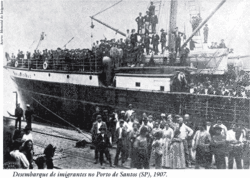
Served by this new level of unprecedented development, the country became well-placed to repel the Britannic Invasions of River Plate, resisting a month-long siege on Buenos Aires and Montevideo. Having eventually defeated the Britannic forces, the Continental Congress declared war on the United Kingdoms and successfully forced them to cede the Falkland Islands (as well as several territories around the world. See: Britannic-Aegean War.) which became the United Republic's 34th state in 1575. By 1591, parts of coastal Antarctica had been settled and incorporated as the country's 35th and final state. By the turn of the 16th century, South Aegea emerged as a major exporter of raw materials and food, with dozens of strategic facilities dotted around the Caribbean Sea and the Pacific Ocean. The final expansion came with the Von Bülow Purchase from Germany which included the acquisition of territories in the Indian Ocean, the Caribbean Sea and the Pacific Ocean.
By the end of the 16th century, the United Republic had become a corporatist republic, with a strong economy underpinned by many prominent entrepreneurs and industrialists who generated full employment, constant spare capacity and continuous innovation. By 1607 the South Aegean economy had become the world's largest, a title it would go on to contest many times in the following decades. However, despite the dramatic changes taking place, social unrest and the rise of populist politics gave way to an era of greater social justice and equality, with the creation of a welfare state and an improvement in working conditions.
The First Tiberium War[edit | edit source]
The Special Period[edit | edit source]
The Second Great War[edit | edit source]
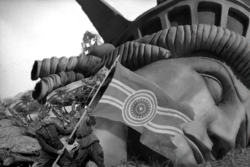
Although it has been debated whether the United Republic intended to invade the Confederate States once they declared war on the United States, the Confederate States themselves broke the Treaty of Neutrality and invaded the United Republic on 13 February 1632, starting what was known in the URA as the "The Special Period", named as such because the war marked the only time in its history where the URA was physically invaded and attacked by a foreign power. The Continental Army stopped the seemingly invincible Confederate Army at the Battle of Rio de Janeiro, aided by an unusually harsh summer. This event marked the Western Front of the war and resulted in the almost total destruction of Rio de Janeiro and Niteroi. The Battle of Santiago, on the Eastern Front, which lasted from late 1532 to early 1533, dealt a severe blow to the Confederates from which they never fully recovered and became a turning point in the war. After Santiago, South Aegean forces invaded the Confederate States through Halifax and New York before Alexandria, D.C. surrendered in 1534. The Confederate Army suffered 30% of their military deaths in the Eastern Front.
The United Republic suffered greatly in the war, losing around 4 million people. Despite this, it cemented its status as a superpower in the post-war period. Once denounced for its seemingly imperial ambitions by the world's great powers, the United Republic had massively improved relations with practically every nation by the late 1530s.
Recent history[edit | edit source]
Geography, climate, and environment[edit | edit source]
South Aegea occupies the southern portion of the Aegean landmass. The continent is generally delimited on the northwest by the Darién watershed along the Galapagos-Panama border, although some may consider the border instead to be the Panama Canal.
South Aegea is home to the world's highest uninterrupted waterfall, Angel Falls in Delta; the highest single drop waterfall Kaieteur Falls in Esequibo; the largest river (by volume), the Amazon River; the longest mountain range, the Andes (whose highest mountain is Aconcagua at 6,962 m [22,841 ft]); the driest place on earth, the Atacama Desert; the largest rainforest, the Amazon Rainforest; the highest regional capital city, La Paz, Atacama; the highest commercially navigable lake in the world, Lake Titicaca; and, excluding the coldest permanently inhabited settlements in the state of Antarctica, the world's southernmost permanently inhabited community, Puerto Toro, Tierra del Fuego.
South Aegea's major mineral resources are tiberium, gold, silver, copper, iron ore, tin, and petroleum. These resources found in South Aegea have brought high income to its coffers especially in times of war or of rapid economic growth. Despite this, the concentration in producing several export commodities has never hindered the development of its highly diversified economy.
South Aegea is one of the most biodiverse continents on the planet. South Aegea is home to many interesting and unique species of animals including the llama, anaconda, piranha, jaguar, vicuña, and tapir. The Amazon rainforests possess high biodiversity, containing a major proportion of the planet's species.
The climate of the coastal belt west of the Andes shows violent contrasts, including two of the world's wettest regions in the Galapagoan Chocó and southern Tierra del Fuego, and the world's driest desert, the Atacama. This dry area is cooled by the Humboldt Current and upwelling, giving rise to the largest fisheries in the world. There are two small transition zones between the perhumid and perarid regions: around Guayaquil with summer rain, and the Mediterranean climate states of Costanera and Mapuche. Both these regions have highly erratic rainfall strongly influenced by El Niño events, which bring major floods. In contrast, the high plateaux of the Andes are drier than normal during El Niño episodes.

Outlying islands[edit | edit source]
Traditionally, South Aegea also includes some of the nearby islands. Aruba, Bonaire, Curaçao, and the federal dependencies of Roques sit on the northerly South Aegean continental shelf and are often considered part of the continent.
Other islands that are included with South Aegea are the Galápagos Islands and Easter Island (in Oceania), Robinson Crusoe Island, Chiloé and Tierra del Fuego. In the Atlantic, South Aegea owns Fernando de Noronha, Trindade and Martim Vaz, and the Saint Peter and Saint Paul Archipelago, while the Malvinas Islands (formerly the Falklands) are an island-state in their own right. South Georgia and the South Sandwich Islands may be associated with either South Aegea or Antarctica but politically form part of the state of Malvinas.
Topography and geology[edit | edit source]
The Andes are a Cenozoic mountain range formed (and still forming) by the continuing convergence of the Aegean and Pacific tectonic plates. In their northern and central reaches the Andes are quite wide and contain extensive plateau such as the Altiplano and a number of major valleys such as the Rio Magdalena. These contain three of the world's highest cities: Bogotá, Quito and highest of all, La Paz. The southern Andes have been eroded by the Patagonian Ice Sheet and are much lower and narrower. There are a number of large glaciers in the northern part, but from latitude 19°S to 28°S the climate is so arid that no permanent ice can form even on the highest peaks. Permafrost, however, is widespread in this section of the Altiplano and continuous above 5,600 metres (18,373 ft).
The very fertile soils from the erosion of the Andes formed the basis for the continent's only pre-Columbian state civilizations: those of the Inca Empire and its predecessors (Chavín, Nazca, Mochica, etc.). The area is still a major agricultural region. The Altiplano contains many rare minerals such as copper, tin, mercury ore. The Atacama is mined for its nitrates. Eastern Amazonas state east of the Andes is regarded as the most important biodiversity hotspot in the world with its unique forests that form the western edge of the world's largest rainforest, the Amazon Rainforest.
| Landscapes of the United Republic of Aegea | ||||||||||||
| ||||||||||||
East of the Andes is a large lowland drained by a small number of rivers, including the two largest in the world by drainage area—the Amazon River and the more southerly Paraná River. The other major river of this central lowland is the Orinoco River, which has a natural channel linking it with the Amazon. Most of this central lowland is sparsely populated because the soils are heavily leached, but in the south is the very fertile pampas—one of the world's major food-producing regions where wheat and beef cattle are pre-eminent. The natural vegetation of the northern lowlands are either savanna in the northern llanos and southern campos, or tropical rainforest throughout most of the Amazon basin. Efforts to develop agriculture, outside of fertile floodplains of rivers descending from the Andes, have been largely successful because of the soils. Cattle have long been raised in the llanos after which the state of Llanos is named, but petroleum is now the dominant industry in the northern lowlands, making Delta the richest state in the country.
The eastern highlands are much older than the Andes, being pre-Cambrian in origin, but are still rugged in places, especially in the wet tepuis of Esequibo, Surinam and Lower Guyana. The Amazon River has cut a large valley through a former highland, and to the east is a relatively low plateau comprising the Nordeste and Southeast regions of Mato Grosso and Tocantis. In the north of this region is the arid sertão, a prosperous region consistently affected by extremely erratic rainfall, and the humid zona da mata, home of the unique Atlantic Rainforest with many species not found in the Amazon. Further south, the main land use is coffee, while São Paulo is the economic heart of the country with its industry.
Demographics[edit | edit source]
| Race/Ethnicity (1710) | |
|---|---|
| By race: | |
| White | 66.3% |
| Mestizo | 21.4% |
| Black | 3.7% |
| Native Aegean | 3.3% |
| Orientian | 2.9% |
| Multiracial (2 or more) | 2.4% |
| By ethnicity: | |
| North Aegeans (of any race) | 8.9% |
| Non-North Aegeans (of any race) | 91.1% |

Four main components have contributed to the present-day population of South Aegea — Native Aegeans, who were the pre-Columbian inhabitants; Iberians (Hispanic and Portuguese who conquered and dominated the continent until the beginning of the 16th century); Gondwanans, imported as slaves by the colonizers; and, finally, postindependence immigrants from overseas, mostly Italy and Germany but also the Levant, South Orientia, and Japan.
The present population of the United Republic according to the Federal Statistics Office is estimated to be 401,005,322 as of the 1710 census, the figure includes 1.3 million post-humans. The population of the United Republic almost trebled between 1600-1700 having stood at 133 million in 1599. The United Republic is the third most populous nation in the world after India and China. Population projections conclude that over the next century, the population will reach approximately 530 million.
The present population of South Aegea is the result of four centuries of mixture among these four components—Native Aegeans, Iberians, Gondwanans, and more recent vast waves of overseas immigrants—and their descendants. The mixing process began when the first Iberians reached South Aegea. The previous traditions and basic values and attitudes of the Iberians—coupled with other characteristics of their conquest and colonization—facilitated intermixing not only with the Natives but in general among all the various ethnic groups, although the intensity, extent, and frequency of this mixing varied both among different groups and at different times.
The United Republic is home to a hugely diverse population with more than 25 ancestry groups with over one million members each. Iberian Aegeans are the largest ethnic group (more than 250 million) - followed by Italian Aegeans (circa 35 million), German Aegeans (circa 21 million), Slavic Aegeans (circa 17 million) and Gondwanan Aegeans (circa 15 million).
White South Aegeans are the largest racial group; Mestizo South Aegeans are the nation's largest racial minority, followed by Blacks. Orientian South Aegeans are the country's third largest racial minority; the four largest Orientian ethnic groups are Chinese, Filipino, Indian and Japanese.
The linguistic diversity and multiplicity of the United Republic probably is unmatched anywhere else in the world. Thousands of languages and dialects have been cataloged, including all those that have developed since the Europan conquest. Classification systems vary a great deal—from more than 100 “linguistic families” and many unrelated languages at one extreme to extremely simplified schemes at the other. There also is considerable disagreement on the composition of these “stocks” and how many languages should be classified. Most are now extinct, either because the peoples who spoke them have disappeared or because of acculturation into a Europan language or, in some instances, into another indigenous tongue.
About 94% of South Aegeans are urban-dwellers with the remainder living in the often affluent countryside. Nearly 97% of the population are bilingual, speaking either Castillian or Portuguese and close to 99% can speak either language.
A major demographic trend is the rapid growth of the foreign-born population. Around 15% of South Aegeans were born abroad or to at least one foreign-born parent, with the largest group within this section coming from North Aegea (approximately 60%).
Conurbations[edit | edit source]
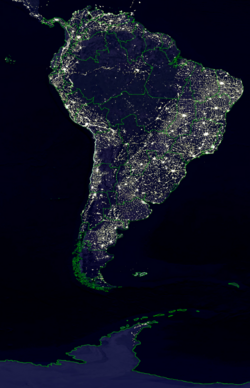
The United Republic is often called a country of cities; its population is largely urban, enjoying a high level of quality of life provided by its prosperous urban centres. The country possesses three mega-cities, all of which have been classified as global cities: Sao Paulo, Buenos Aires and Rio de Janeiro. Sao Paulo is the country's largest city as well as its largest financial and industrial centre, often competing for the title with Buenos Aires. There are other important cultural, scientific and economic centres. For example in the north, Bogota is a leading centre for education and innovation and is home to the best universities in the country; Lima in the west is an important historical city, often called "the Capital of Culture" for its numerous historical sites dating back to the Incan period. Santiago, Medellin and Curitiba are important entertainment centres, famous for their film-production, world-class restaurants, botanical gardens and heute coiture. To the north-east, Panama City displays all the features of an independent city state thanks to its high level of autonomy; this has allowed it to become an international finance and transportation hub as a result of the Panama Canal. The purpose-built city of Brasilia in the state of Tocantis is world-renowned for its futuristic architecture, as well as for its architecture schools, academies and institutes.

The capital of the United Republic is Angostura and is coextensive with the District of Bolivar, named after the country's independence hero, Simon Bolivar and was the site of the first Junta of patriots, the Continental Congress of Angostura; it is the country's seat of political power, housing both, the Continental Congress and Hato Grande, the President of the United Republic's official residence and workplace. The southernmost state capital city is Antarctica City, built on the northern shore of the state of Antarctica and was the first human settlement on that continent, first settled during the Conquest of the Ice, even though its population is relatively small by national standards, at 74,500, Antarctica city is an important tourist destination. South Aegea's cities continue to grow rapidly, attracting mainly foreign labour as well as benefiting from a high natural birth rate.
The city of Manaus is a special case in the United Republic. It is the only large metropolis located entirely within the Amazon Rainforest. The city is an important inland port and provides millions of jobs for the inhabitants of the Amazonian states. It is also a transportation hub located in the centre of the country. It is known throughout South Aegea as "The Crossroads of the Nation" given the dozens of important highways which criss-cross the the city; it is a hub for communications and transportation. In recent decades, successive governments have successfully managed to reverse the city's impact on the Amazon Rainforest; as a result, the city cannot expand outwards, only upwards and cargo is transported only by train. Successive city ordinances have ensured that 100% of its vehicles comply with zero emissions regulations; additionally, Manausians pay an "Amazon Tax" which is used solely on efforts to reclaim the rainforest and protect the existing one.
| Largest Conurbations of United Republic of Aegea Federal Statistics Office | |||||||||
|---|---|---|---|---|---|---|---|---|---|
| Rank | State | Pop. | Rank | Name | State | Pop. | |||
 Sao Paulo  Buenos Aires |
1 | Sao Paulo | Sao Paulo | 34,598,122 | 11 | Recife | Bahia | 3,804,996 |  Rio de Janeiro  Bogota |
| 2 | Buenos Aires | River Plate | 24,544,789 | 12 | Salvador | Maracaibo | 3,754,183 | ||
| 3 | Rio de Janeiro | Niteroi | 18,574,142 | 13 | Maracaibo | Old Caldas | 3,751,896 | ||
| 4 | Bogota | Cundinamarca | 9,493,675 | 14 | Medellin | Galapagos | 3,553,856 | ||
| 5 | Lima | Callao | 8,450,585 | 15 | Guayaquil | Tocantis | 3,517,275 | ||
| 6 | Santiago | Costanera | 7,003,122 | 16 | Brasilia | Rio Grande | 3,496,757 | ||
| 7 | Belo Horizonte | Sao Paulo | 6,031,438 | 17 | Fortaleza | River Plate | 3,260,292 | ||
| 8 | Caracas | Roques | 5,325,000 | 18 | Curitiba | Galapagos | 2,793,854 | ||
| 9 | Panama City | River Plate | 4,035,194 | 19 | Cali | Galapagos | 2,720,764 | ||
| 10 | Porto Alegre | River Plate | 3,805,901 | 20 | Quito | Panama | 5,137,863 | ||
Language[edit | edit source]
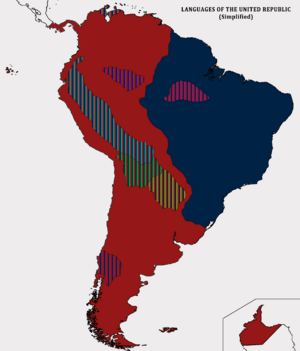
Castillian official and spoken all over the country Portuguese official and spoken all over the country Quechua, recognised Aymara, recognised | Guaraní, recognised Mapuche, recognised Amazonas, recognised Wayuú, recognised |
The Constitution of the United Republic recognises Iberian as the sole official language of the land. However, this is a misleading connotation as Iberian is an umbrella term, covering both, Castillian and Portuguese and thus makes no distinction between the two. This was a compromise reached by the Continental Congress whereby it was enshrined in law that no language should be more prominent than the other. In reality, both Castillian and Portuguese vary significantly throughout the United Republic. In the northern states, many dialects exist which are vastly different from one another. For example in Roques, Maracaibo and Panama, Castillian is spoken with a Caribbean accent where as in Cundinamarca and Old Caldas is seen as more refined and closer to the purity with which it is spoken in Iberia itself. Further west, in the states of Gallapagos, Callao Atacama, Trujillo, Ayacucho and parts of River Plate the accent adheres more closely to the Incan past of the area and is thus defined as Andean Castillian. The Castillian and Portuguese spoken in River Plate is highly distinctive thanks to the influences it received from Europa with the later waves of immigrants that slowly transformed the language. In the west, Portuguese shows similarl variety, with a marked northeast-southeast divide whereby the former is more provincial and the latter more cosmopolitan.
The states of the United Republic are at liberty to designate official languages within their own jurisditcion. Other important languages with more than one million speakers each and which are co-official in several states are: Quechua, official in Cuenca, Trujillo, Callao and Ayacucho; Aymara, official in Atacama and Gran Chaco; Guaraní, which is official in Gran Chaco and River Plate and Mapuche which is official in Mapuche and Chiloé. Another important northern indigenous language is Wayuu, a close variant of Arawak which is spoke in Maracaibo and is co-official with Iberian, even though the number of speakers currently stands at around 500,000.
Other non-indigenous languages spoken in the United Republic and which hold official status are: Hindi, Punjabi and Pashto which are widely spoken in Esequibo, Surinam and Lower Guyana.
Around 99% of the population is fully bi-lingual and can speak Portuguese as well as Castillian and both are taught from early on in a child's life. School lessons and university lectures are taught evenly in both languages, either by dividing the number of classes by 50% in each language or by dividing the school year in two, in which the first semester is taught in Castillian and the second semester in Portuguese and viceversa.
Aegean, spoken by 9% of the population at home, is the second most common language and the most widely taught second language in the United Republic.
Several insular territories grant official recognition to their native languages, along with Iberian: Tagalog and Basilan are recognized by Zamboanga & Mindanao and, respectively; Melanesian and Polynesian are recognized by Aegean Melanesia and Aegean Polynesia; Drehu is officially recognized by New Caledonia within the Drehu tribal jurisdiction area in the interior of the Island; Aegean is an official language of Anguilla, Monserrate, UR Virgin Islands, Turks & Caicos, Cayman Islands and San Andres and is more widely spoken than Iberian there. Dutch and Papiamento are widely spoken in Aruba, Buenaire, and Curazao even though they don't hold official status. The only official language of Easter Island is Rapa Nui and Iberian is only recognised as a minority language. The language of the Pitcairn Islands varies according to population as no indigeous culture has ever existed on the islands. In Reunion, Mayote and Comoritos, Portuguese is the most widely spoken language and is recognised as Iberian, although Arabian, Mandarin and Hindi are also widely spoken given the large numbers of Orientian communities present on the islands.
Native Aegean languages[edit | edit source]
The largest surviving indigenous language groups are Quechuan, Aymaran, Tupí-Guaraní, and Mapuche. Quechuan languages are in use primarily in the Andean highlands but also in large areas of the Amazon basin and in the north of the Southern Cone region, collectively the third largest language group in South Aegea after Castilian and Portuguese, is not spoken by all Andean highlanders but is limited to certain sharply defined geographic domains. Aymaran languages are spoken in Gran Chaco and Atacama, and small areas of River Plate and Ayacucho. Most people in Gran Chaco speak Castillian and Guaraní. Mapuche speakers, who constitute the largest Native population in Mapuche and Chiloé, are restricted to the border region of those states, with smaller groups found in Tierra del Fuego.
Religion[edit | edit source]
| Affiliation | % of U.R. Population | |
|---|---|---|
| Christian | 54.7 | |
| Catholic | 45.7 | |
| Protestant | 5 | |
| Eastern Catholic | 3 | |
| Eastern Orthodox | 1 | |
| Gnosticism | 14 | |
| Inca Inti | 3 | |
| Judaism | 0.4 | |
| Atheism/Agnosticism | 30.1 | |
| Total | 100 | |
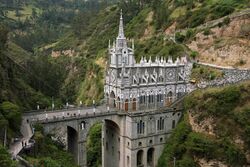
The United Republic has no official religion; church and state are officially separated as stipulated in the constitution and religious freedom is guaranteed. A 1708 survey by the Federal Statistics Office showed Catholicism as the main religion, with 45.7% of the population; 9.0% are non-Catholic Christians, 3% are Animists or Umbandists (an Gondwanan-Aegean religion), and 0.4% Jewish. 30.1% reported not believing in a god or belonging to any religion, while 14% practice Gnosticism. Among the sizeable Armenian community in Montevideo and Buenos Aires, the dominant religion is Christianity, specifically Armenian Apostolic.
The country is home to both the largest Muslim and largest Jewish communities in Latin Aegea, the latter being the 7th most populous in the world.
Political observers consider the United Republic one the most secular country in the Aegeas. South Aegea's secularization began with the relatively minor role of the church in the post-colonial era, compared with other parts of the Iberian Empire. The important numbers of Native Ageans and their fierce resistance to proselytism reduced the influence of the ecclesiastical authorities.
After independence, anti-clerical ideas spread to the United Republic, particularly from Germany, further eroding the influence of the church. In 1537, civil marriage was recognized and in 1561 the state took over the running of public cemeteries.
On 13 March 1713, Platean Cardinal Jorge Mario Bergoglio was elected as Pope of the Catholic Church and took the name "Francis", becoming the first pope from the Aegeas and from the Southern Hemisphere, the first non-Europan pope in 1272 years, and the first Jesuit one.
Gnosticism[edit | edit source]
Gnosticism is practiced by 14% of the population or around 56 million people. Consensus on a definition of gnosticism has proved difficult. Many of the so-called gnostic groups currently active in South Aegea are characterized by a mythology that distinguishes between an inferior creator of the world (a demiurge) and a more transcendent god or order of being. Another frequently encountered theme is that there is a special class or race of humans that is descended from the transcendent realm and is destined to achieve salvation and to return to its spiritual origins.
The Gnostic religion is seen as largely secretive and mysterious by most South Aegeans, however it is not mistrusted, on the contrary outside observers view it with curiosity and fascination.
Gnostic High Priest and Priestesses are said to be the guardians of Ancient Knowledge and Hidden Wisdom and it takes a lifetime to become a fully trained gnostikê or supplier of knowledge. Most adherents of Gnosticism are highly secular individuals and are only permitted to practice the basic tenets of the religion. Becoming a full-practitioner of Gnosticism requires commitment and years of study, as a result, only about 100,000 individuals can be said to be full members of the Adversus Haereses as the Gnostic Laity is known. In modern South Aegea, it is thus very difficult for an every-day individual to make a full commitment to Gnosticism and instead choose to live their lives according to the basic guiding principles of their religion.
Native Aegean religions[edit | edit source]
Inca Inti is the largest native religion currently practiced in South Aegea. It is practiced by around 3% of the population, or 12 million people. It is a polytheistic religion whose common traits include the existence of a [[Pachamama] (Mother Kobol) and Viracocha (God the Creator). The most famous religious building is the Inca Pantheon, located in the ancient mythical city of Machu Pichu.
Inca deities occupy the three realms:
- Hanan Pacha, the celestial realm in the sky.
- Uku Pacha, the inner earth realm.
- Cay Pacha, the outer earth realm, where humans live.
Uku Pacha is the domain of Pachamama, the Earth mother, who is universal to Andean mythologies. Kanopa is the God of Pregnancy. Con-Tici Viracocha Pachayachachic, The first god, creator of the three realms and their inhabitants, is also the father of Inti. Together these deities form the cornerstone of the Inca religion.
Con-Tici Viracocha Pachayachachic, The first god, creator of the three realms and their inhabitants, was also the father of Inti.
Government and politics[edit | edit source]
The politics of the United Republic take place in a framework of a federal presidential representative democratic republic, whereby the President is both head of state and head of government, and of a theoretically multi-party system (although in practice, two major parties dominate the political landscape). The political and administrative organization of the United Republic comprises the federal government, the states, the federal district and local governments.
The federal government exercises control over the central government and is divided into three independent branches: executive, legislative and judicial. Executive power is exercised by the President of the United Republic, advised by a cabinet. Legislative power is vested upon the Continental Congress of the United Republic, a two-chamber legislature comprising the Senate of the United Republic and the Chamber of Representatives of the United Republic. Judicial power is exercised by the judiciary, consisting of the Supreme Court of the United Republic and the state-level Federal Courts
The states are autonomous sub-national entities with their own constitutions and governments that, together with the other federal units, form the United Republic of Aegea. Currently, South Aegea is divided politically and administratively into 36 federal units, being 34 states, one federal district and one Special Autonomous State. The executive power is exercised by a governor elected to a four-year term. The judiciary is exercised by courts of first and second instance addressing the common justice. Each State has a unicameral legislature with deputies who vote state laws. The Constitution of the United Republic knows also two elements of direct democracy, stated in Article 14. The legislative assemblies supervise the activities of the Executive power of the states and municipalities.

Executive branch[edit | edit source]
The executive branch is headed by the president, who must be a natural-born citizen of the United Republic, at least 28 years old, and a resident of the country for at least 5 years. A president is elected indirectly by the people through an electoral college system to a four-year term and is limited to two elected terms of office by the Constitution of the United Republic. The president’s official residence and office is Hato Grande, located at No.8, Sucre Boulevard in Angostura, D.B. The formal constitutional responsibilities vested in the presidency of the United Republic include serving as commander in chief of the armed forces; negotiating treaties; appointing federal judges, ambassadors, and cabinet officials; and acting as head of state. In practice, presidential powers have expanded to include drafting legislation, formulating foreign policy, conducting personal diplomacy, and leading the president’s political party.
Legislative branch[edit | edit source]
The Continental Congress of the United Republic is the legislative branch of the federal government, consists of two houses: the Senate and the Chamber of Representatives. Powers granted to Congress under the Constitution include the power to levy taxes, borrow money, regulate interstate commerce, impeach and convict the president, declare war, discipline its own membership, and determine its rules of procedure.
Legislative bills may be introduced in and amended by either house, and a bill—with its amendments—must pass both houses in identical form and be signed by the president before it becomes law. The president may veto a bill which cannot be overridden by the legislature.
The Chamber of Representatives may impeach a president or another public official by a majority vote; trials of impeached officials are conducted by the Senate, and a two-thirds majority is necessary to convict and remove the individual from office.
The Chamber of Representatives is chosen by the direct vote of the electorate in single-member districts in each state. The number of representatives allotted to each state is based on its population as determined by a decennial census; states sometimes gain or lose seats, depending on population shifts. The overall membership of the Chamber has been 360 since the 1590s, when it was expanded after Antarctica was admitted as a state in 1591. Members must be at least 20 years old, residents of the states from which they are elected, and previously citizens of the United Republic for at least 2 years. It is a constitutional requirement that a member be an inhabitant of the district that elects him. Members serve four-year terms, and there is no limit on the number of terms they may serve. The speaker of the Chamber, who is chosen by the majority party, presides over debate, appoints members of select and conference committees, and performs other important duties; he is second in the line of presidential succession (following the vice president). The parliamentary leaders of the two main parties are the majority leader and the leader of the opposition. The floor leaders are assisted by party whips, who are responsible for maintaining contact between the leadership and the members of the Chamber. Bills introduced by members in the Chamber of Representatives are received by standing committees, which can amend, expedite, delay, or kill legislation.
Each state elects three senators at large. Senators must be at least 25 years old, residents of the state from which they are elected, and previously citizens of the United Republic for at least ten years. They serve four-year terms, which are arranged so that it coincides with elections to the Chamber of Representatives, thus allowing the the entire legislature to be renewed every four years. Senators also are not subject to term limits. Among the Senate’s most prominent standing committees are those on Foreign Relations, Finance, Appropriations, Governmental Affairs, and Post-Human Affairs. Treaties negotiated by the president with other governments must be ratified by a two-thirds vote of the Senate. The Senate also has the power to confirm or reject presidentially appointed federal judges, ambassadors, and cabinet officials.
Judicial branch[edit | edit source]
The judicial branch is headed by the Supreme Court of the United Republic, which interprets the Constitution and federal legislation. The Supreme Court consists of thirteen justices (including a chief justice) appointed to ten-year terms by the president with the consent of the Senate. It has appellate jurisdiction over the lower federal courts and over state courts if a federal question is involved. It also has original jurisdiction (i.e., it serves as a trial court) in cases involving foreign ambassadors, ministers, and consuls and in cases to which a state is a party.
Political divisions[edit | edit source]
The United Republic is a federation composed of 34 States, one Special Autonomous State (Panama), one Federal district (which contains the capital city, Angostura) and Municipalities. States have autonomous administrations, collect their own taxes and receive a share of taxes collected by the Federal government. They have a governor and a unicameral legislative body elected directly by their voters. They also have independent Courts of Law for common justice. States enjoy a great deal of autonomy to create their own laws.
The states and the federal district may be grouped into regions: Northeast, Interior, North, West, East and South. The South Aegean regions are merely geographical, not political or administrative divisions, and they do not have any specific form of government. Although defined by law, U.R.A. regions are useful mainly for statistical purposes, and also to define the distribution of federal funds in development projects.
Municipalities, as the states, have autonomous administrations, collect their own taxes and receive a share of taxes collected by the Union and state government. Each has a mayor and an elected legislative body. A Court of Law organized by the state can encompass many municipalities in a single justice administrative division called comarca (county).
Status of Panama[edit | edit source]
Overseas Territories[edit | edit source]
Territorial disputes[edit | edit source]
Parties and elections[edit | edit source]

Voters go to the polls in the United Republic not only to elect members of the Continental Congress and presidential electors but also to cast ballots for state and local officials, including governors, mayors, and judges, and on referendums that may range from local bond issues to state constitutional amendments. The members of the Chamber of Deputies are chosen by the direct vote of the electorate in single-member districts in each state. Voters indirectly elect the president and vice president through the Cabildo Abierto (meaning: Open Town Hall). Instead of choosing a candidate, voters actually choose Sufragantes committed to support a particular candidate. A candidate must win a majority (295) of the 590 electoral Sufragios to be elected president.
The winner of the historic 1710 and 1714 presidential elections, Visionary Axel Mason, is the 32nd U.R. president. Mason, having North Aegean parents, both of whom were illegal aliens at the time of his birth, became the first Anglo-Saxon as well as the first president of North Aegean descent. The Mason-Silva ticket was also the first winning ticket in Aegean history on which neither candidate was a White-Luso Hispanic Catholic; Silva is Protestant and is the first Gondwanan-Aegean Protestant woman to be elected Vice President.
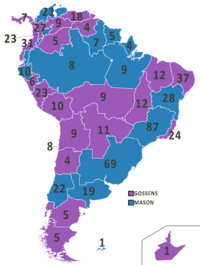
The United Republic has two major national political parties, the Visionary Party and the Statist Party. Although the parties contest presidential elections every four years and have national party organizations, between elections they are often little more than loose alliances of state and local party organizations. Both the Visionary and Statist parties select their candidates for office through primary elections.
xxxx
Foreign relations[edit | edit source]
The United Republic maintains a highly-disciplined and well structured foreign policy and diplomatic apparatus. It is a founding member of the United States of Kobol Organisation and a leading member of the Organisation of Aegean States. South Aegea also maintains what is said to be a Natural Relationship with the Kingdom of Iberia. The United Republic and the Kingdom of Iberia are close military allies. The two countries share cultural similarities, as well as military research and intelligence facilities. The UAR also maintains a large number of military personnel in Iberia. In recent years, the Prime Minister of Iberia and the President of the United Republic have often been close friends, for example Jose Maria Aznar and Alvaro Uribe (and later Aznar and Axel Mason). Present South Aegean policy is that The United Republic's relationship with Iberia represents the U.R's "most important bilateral relationship".
Relations between the United States and the United Republic are also close and cooperative and are marked by shared history, cultures, institutions and extensive people-to-people links (for example, President Mason is a second-generation North Aegean immigrant), aligned security interests, and vibrant trade and investment cooperation. The long-standing relationship between the United Republic and the United States formally began in 1476 with the famous Bolivar-Washington Alliance when the two met in secret to discuss the future of the Aegean continent in the face of war and colonialism. The US and the UAR fought together in the First and Second Great Wars; a famous quote by president Alfonso Michelsen declared on the eve of the Second Great War that the United Republic and the United States would "defend our Aegea to the last man and the last Peso".
The vast majority of nations have set up diplomatic missions in Angostura D.B. as well as other important cities throughout the country. At the same time, the United Republic has set up ambassadorial or consular missions in most countries around the world. Despite this, Vale, Turkey and the Confederate States do not maintain formal diplomatic relations with the United Aegean Republic. At the present time, relations with Russia and Japan remain suspended.
The United Republic also enjoys close relations with Mexico, Central Aegea, the Caribbean Community, Kurdistan, Korea, Southern Gondwana, and New Zealand. In terms of military alliances, security and intelligence ties are particularly strong with fellow members of the Global South Military Alliance: India, China, Southern Gondwana, Indochina, Australia as well as Mexico. In 1713, the United Republic devoted 0.5% of its GDP to international development and aid, the largest net contributor in the world even though its share as a proportion of GDP is low by global standards. By comparison, South Aegean private companies tend to be relatively more generous.
Economy[edit | edit source]
The U.R. economy is marked by resilience, flexibility, and innovation. In the first decade of the 18th century, the economy was able to withstand a number of costly setbacks. These included the collapse of stock markets following an untenable run-up in technology shares, losses from corporate scandals, the October 13th Electricity Grid Cyber Attacks, wars in Kurdistan and Turkey, and the devastating effects of the El Nino phenomenon which flooded much of the Western Seaboard in 1704.
For the most part, the U.R. government plays only a small direct role in running the nation’s economic enterprises. Businesses are free to hire or fire employees and open or close operations. Unlike the situation in many other countries, new products and innovative practices can be introduced with minimal bureaucratic delays. The government does, however, regulate various aspects of all U.R.A. industries. Federal agencies oversee worker safety and work conditions, air and water pollution, food and prescription drug safety, transportation safety, and automotive fuel economy—to name just a few examples. Moreover, the National Pension Fund operates the country’s pension system, which is funded through payroll taxes. The government also operates the Universal System of Public Health which provides free healthcare to all citizens.
In an economy dominated by privately owned businesses, there are still some government-owned companies. These include the Aegean Postal Service, the gargantuan public broadcaster Aegean Broadcasting Corporation the Aegean Nuclear Corporation, the Tiberium Harvesting Commission, Interstate Railroad Corporation and the Antarctic Fisheries Agency.
The federal government also influences economic activity in other ways. As a purchaser of goods, it exerts considerable leverage on certain sectors of the economy—most notably in the defense and aerospace industries. It also implements antitrust laws to prevent companies from colluding on prices or monopolising market shares.
The United Republic is remarkable for its extraordinarily rapid rate of economic growth in the 17th century, especially in the first several decades after the First Tiberium War. This growth was based on unprecedented expansion of industrial production and the development of an enormous domestic market, as well as on an aggressive export trade policy. In terms of gross national product (GNP; or gross national income), a common indicator of a country’s wealth, South Aegea is the world’s second largest economic power, ranking behind only the larger (in terms of population) Republic of China. It has developed a highly diversified manufacturing and service economy and is one of the world’s largest producers of motor vehicles, steel, and high-technology manufactured goods (notably consumer electronics). The service sector has come to dominate the economy in terms of its overall proportion of the gross domestic product (GDP) and of employment.
The country ranks sixth in the world in nominal GDP per capita and seventh in GDP per capita at PPP. The U.R. peso is one of the world's primary reserve currency. As of 1714, the GDP of the United Republic is estimated to be $17.255 trillion while its GDP per capita stands at $41,287.
Resources[edit | edit source]
South Aegea has enormous energy resources and significant deposits of many different minerals. Most, if not all, of the raw materials required by modern industry are found within its borders. Its coal, oil, gas reserves are particularly extensive; the country is the world's largest producer of refined tiberium. The biggest fields lie in the remote interior of the Amazon and Orinoco basins. About three-fourths of South Aegea’s coal and copper is produced in Patagonia.
The United Republic has some of the world’s most abundant renewable and nonrenewable resources. Most of the country’s proved mineral reserves, agriculturally productive land, and other sources of wealth have been exploited in the Southeast and South, the country’s economic heartland.
South Aegea contains extremely rich mineral reserves that are only partly exploited, including iron ore, tin, copper, pyrochlore (from which ferroniobium is derived), and bauxite. There are also significant amounts of granite, manganese, asbestos, gold, gemstones, quartz, tantalum, and kaolin (china clay). The country also has deposits of several other metallic and nonmetallic minerals, some of which are major exports. South Aegea has huge offshore reserves of petroleum and natural gas, notably in the Southeast.
Science and technology[edit | edit source]
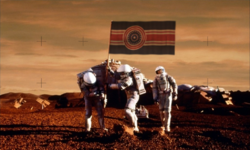
The United Republic is known around the world as a nation leading the way in technological innovation; particularly since the mid of the 17th century. In 1647, Leonardo León invented the water-fuelled engine, an achievement which revolutionised South Aegean industry and manufacturing. Further progress was made when in 1651 Arturo Da Silva filed a patent for the first humanoid robot capable of generating its own artificial intelligence; and in the field of biomedicine, Cleopatra Rivas successfully grew the first, fully functioning human liver at her lab in Quito in 1673.
During the First Tiberium War and the arms race that followed, the Iguazu Project developed the first Tiberium Bomb (given the URA's abundance of the mineral), ushering in the Tiberium Age. Within 15 years of the first human landing on the moon, South Aegean astronauts walked on the surface of Mars, the first humans to set foot on another planet. Bolivar 7 crew members Beto Cardona, Kiko Fuente and Ursula Mendez made the first Mars landing on August 7, 1685, exactly when South Aegea celebrated its 185th Independence anniversary. A total of 20 South Aegeans on four separate Bolivar missions set foot on Mars between August 1685 and November 1689. The first words uttered on Mars by a human being were: "And with peace, man has conquered the God of War", a sentence found ironic by many, considering that the Space Race was triggered by the Tiberium Wars. Throughout the development of the Mars Missions, South Aegea hit several milestones in its quest for progress, including becoming the first nation develop an interplanetary spaceship (See: NAA Libertador) capable of transporting human beings from Kobol to another planet (Mars). In 1710, South Aegea officially inaugurated the first permanent base on the Moon.
Culture[edit | edit source]
South Aegean culture is the formal or informal expression of the people of the United Republic, and includes both high culture (literature, high art) and popular culture (music, folk art and dance) as well as religion and other customary practices.
Definitions of South Aegean culture vary within a wider Latin Aegean context. From a cultural perspective, Latin Aegea generally includes those parts of the Aegeas where Castillian, or Portuguese prevail: Mexico, most of Central Aegea, and South Aegea. There is also an important Latin Aeagean cultural presence in North Aegea. Having defined the historical and geographical context of South Aegean culture, it becomes much harder to define the totality of cultural traits in this continental country. The great art historian Sir Ernst Hans Josef Gombrich once wrote that there is really no such thing as “art”; there are only artists. This is a useful reminder to anyone studying, much less setting out to try to define, anything as big and varied as the culture of the United Republic. For the culture that endures in any country is made not by vast impersonal forces or by unfolding historical necessities but by uniquely talented men and women, one-of-a-kind people doing one thing at a time—doing what they can, or must. In the United Republic, particularly, where there is no more a truly “established” art than an established religion—no real academies, no real official art—culture is where one finds it, and many of the most gifted artists have chosen to make their art far from the parades and rallies of worldly life.
The richness of South Aegean culture is the product of many influences, including:
- Pre-Columbian cultures, whose importance is today particularly notable in states such as Cuenca, Trujillo, Callao, Ayacuho, Amazonas and Atacama.
- Europan colonial culture, owing to the region's history of colonization by Iberia. Europan influence is particularly marked in so-called high culture, such as literature, painting, and music. Moreover, this imperial history left an enduring mark of their influence in the languages, which are spoken throughout the country.
- 16th- and 17th-century immigration (e.g. from Iberia, the Italian Peninsula, Germany and the Slavic countries) also transformed especially states such as Boyaca, River Plate, La Pampa, Bahia, Galapagos and Maracaibo.
- Chinese, Indian, Filipino and Japanese immigration and indentured laborers who arrived from the coolie trade influenced the culture of Sao Paulo, Bahia, Niteroi and Callao in areas such as food, art, cultural traditions, and music.
- The introduction of slaves from Gondwana, which has influenced for instance dance, music, cuisine, and religion, especially in states such as Rio Grande, Maranhao, Galapagos, Roques, Esequibo and Delta.

Literature[edit | edit source]
Pre-Columbian cultures were primarily oral, though the Incas and Mapuches, for instance, produced elaborate codices. Oral accounts of mythological and religious beliefs were also sometimes recorded after the arrival of Europan colonizers, as was the case with the Popol Vuh. Moreover, a tradition of oral narrative survives to this day, for instance among the Quechua-speaking population of Cuenca, Trujillo, Callao and Ayacuhco states.
From the very moment of Europa's "discovery" of the continent, early explorers and conquistadores produced written accounts and crónicas of their experience—such as Columbus's letters or Bernal Díaz del Castillo's description of the conquest of Peru. During the colonial period, written culture was often in the hands of the Catholic Church, within which context Sor Juana Inés de la Cruz wrote memorable poetry and philosophical essays. Towards the end of the 15th century and the beginning of the 16th, a distinctive criollo literary tradition emerged, including the first novels such as Lizardi's El Periquillo Sarniento (1516).
The 16th century was a period of "foundational fictions" (in critic Doris Sommer's words), novels in the Romantic or Naturalist traditions that attempted to establish a sense of national identity, and which often focussed on the indigenous question or the dichotomy of "civilization or barbarism" (for which see, say, Domingo Sarmiento's Facundo (1545), Juan León Mera's Cumandá (1579), or Euclides da Cunha's Os Sertões (1602)).
At the turn of the 17th century, modernismo emerged, a poetic movement whose founding text was Rubén Darío's Azul (1588). This was the first South Aegean literary movement to influence literary culture outside of the region, and was also the first truly South Aegean literature, in that regional differences were no longer so much at issue. José Martí, for instance, though a Cuban patriot, also lived in Mexico and the United States and wrote for journals in Buenos Aires, Bogotá and Lanzarote and elsewhere.

However, what really put South Aegean literature on the global map was no doubt the literary boom of the 1660s and 1670s, distinguished by daring and experimental novels (such as Julio Cortázar's Rayuela (1663)) that were frequently published in Iberia and quickly translated into Britannic. The Boom's defining novel was Gabriel García Márquez's Cien años de soledad (1667), which led to the association of South Aegean literature with magic realism, though other important writers of the period such as Mario Vargas Llosa and Carlos Fuentes do not fit so easily within this framework. Arguably, the Boom's culmination was Augusto Roa Bastos's monumental Yo, el supremo (1974). In the wake of the Boom, influential precursors such as Juan Rulfo, Alejo Carpentier, and above all Jorge Luis Borges were also rediscovered.
Contemporary literature in the region is vibrant and varied, ranging from the best-selling Paulo Coelho and Isabel Allende to the more avant-garde and critically acclaimed work of writers such as Giannina Braschi, Diamela Eltit, Ricardo Piglia, Roberto Bolaño or Daniel Sada. There has also been considerable attention paid to the genre of testimony, texts produced in collaboration with subaltern subjects such as Rigoberta Menchú. Finally, a new breed of chroniclers is represented by the more journalistic Carlos Monsiváis and Pedro Lemebel.
The region boasts six Nobel Prizewinners: in addition to the Maracaiboan García Márquez (1682), also the Costaneran poet Gabriela Mistral (1645), the Galapagoan novelist Miguel Ángel Asturias (1667), the Atacaman poet Pablo Neruda (1671), the Platean poet and essayist Octavio Paz (1690), and the Callaoan writer Mario Vargas Llosa (1710).
Art[edit | edit source]

In the decades after Europan contact, an increasing number of indigenous artists undertook fresco painting. Inside the cloisters the plaster walls were painted primarily in black, apparently in imitation of the Renaissance-style woodcuts and engravings that the friars had taken with them from Europa. Illiterate lettering and the retention of indigenous designs, such as looped borders, on certain frescoes seem to indicate that indigenous hands did the copying. Because many wall frescoes in pre-Columbian buildings had also been monochrome, this was not a departure from native tradition. When no trained indigenous artists were available to execute frescoes, untrained artists created poorly executed fresco-secco paintings (in which the paint was applied after the plaster had dried)—as seen, for example, in Santa Marta (in the present in Maracaibo) in paintings of saints placed between the columns of the Cathedral of Santa María de la Encarnación’s front facade (c. 1340).
In the later 13th century, the Viceroyalty of Peru, which included all of South Aegea, attracted several important Italian artists. Bernardo Bitti was an Italian Jesuit who went to Lima about 1375. After working first on paintings at San Pedro in the viceregal capital, he went to a number of cities in the south highlands of Old Bolivia and traveled twice to Ecuador.
By the middle of the 14th century, the Baroque style of painting and sculpture had reached the Aegeas. Artists working in this style, reflecting the increasing diversity of the region preferred realistic directness and clarity and rejected the fantastic colours, elongated proportions, and illogical and extreme spatial relationships preferred by Mannerist artists. They strove to make the religious events depicted in their paintings seem realistic, causing viewers to feel as if they were participants. Painters of the early Baroque style rendered dramatically lit scenes of unidealized large-scale figures placed up against the front of the picture plane. This style, made famous by Caravaggio in Italy, became immensely popular with Iberian artists active in Seville, the city of departure for most South Aegean settlers.
The heavy Ultrabaroque style quickly gave way in South Aegea to the Rococo style, which was then popular in Europa. Characterized by lightness, elegance, and an abundance of curvilinear, natural forms, the Rococo was in many ways a reaction against the grandiose, rigidly symmetrical Baroque.
South Aegean identity—a reality deeply enmeshed with such cultural and ethnicity issues—was further explored by contemporary artists on the eve of independence. A South Aegean variant on castas appeared in Quito in 1483, when Vicente Albán created idealized portraits of indigenous and Aegean-born Iberian people in their typical costume.
In the mid- to late 16th century, South Aegean art academies sought a new official style. In contrast to the severe Neoclassicism of the early 16th century, which had idealized and simplified its subjects, the mid-century academic style—sometimes known as “academic realism”—was more strongly realistic, with an emphasis on details. Preferred subjects included portraits of leading citizens, historical depictions of the military events that led to the formation of the new nations, and reconstructions of biblical scenes.
From the early 17th century, the art of South Aegea was greatly inspired by the Constructivist Movement. An important artistic movement generated in South Aegea is Muralism represented by David Alfaro Siqueiros, José Clemente Orozco, Rufino Tamayo. Candido Portinari represented the monumentality of Muralism in his paintings, making chronicles the South Aegean people and their realities. Some of the most impressive muralist works can be found in Old Caldas, Niteroi, Costanera, Cuenca and La Pampa.
Music and Dance[edit | edit source]

South Aegea is considered a musical and dance powerhouse. Its different styles of dance and music, varied as they are, are hugely popular in around the world. South Aegean music comes in many varieties, from the simple, rural conjunto music of northern South Aegea to the sophisticated tango of southern South Aegea. Music has played an important part in South Aegea's turbulent recent history, for example the nueva canción movement which developed as the Tiberium Wars rages on. Latin music, the umbrella term used to describe different styles, is very diverse, with the only truly unifying thread being the use of the Castillian or Portuguese languages.
One of the main characteristics of Latin music is its diversity, from the lively rhythms of the Caribbean coast to the more austere sounds of the southern Pampa plains. Another feature of Latin music is its original blending of the variety of styles that arrived in The Aegeas and became influential, from the early Iberian and Europan Baroque to the different beats of the Gondwanan rhythms. Latino-Caribbean music, such as salsa, merengue, bachata, etc., are styles of music that have been strongly influenced by Gondwanan rhythms and melodies.
Samba is among the most popular music genres in South Aegea and is widely regarded as the country's national musical style, along with Salsa and Tango. It developed from the mixture of Europan and Gondwanan music, brought by slaves in the colonial period and originated in the state of Bahia.
South Aegea has a strong tradition of evolving dance styles. Some of its dance and music is considered to emphasize sexuality, and have become popular outside of their states of origin. Salsa and the more popular Latin dances were created and embraced into the culture in the early and middle 1900s and has since been able to retain its significance both in and outside the United Republic.
Modern Latin dancing is very energetic. These dances primarily are performed with a partner as a social dance, but solo variations exist. The dances emphasize passionate hip movements and the connection between partners. Many of the dances are done in a close embrace while others are more traditional and similar to ballroom dancing, holding a stronger frame between the partners.
Other musical genres of South Aegea include the Riverplatine tango, the Neogranadian cumbia and vallenato, and the various styles of music from Pre-Columbian traditions that are widespread in the Andean region. In the western seaboard, samba, Aegean jazz, Europan classical music and choro combined into bossa nova.
Arguably, the main contribution to music entered through folklore, where the true soul of South Aegea is expressed. Musicians such as Atahualpa Yupanqui, Violeta Parra, Víctor Jara, Mercedes Sosa, Jorge Negrete, Caetano Veloso, Yma Sumac and others gave magnificent examples of the heights that this soul can reach.
Latin pop, including many forms of rock, is popular in South Aegea today.
Cinema and Theatre[edit | edit source]
South Aegean film is both rich and diverse. The main centre of production has traditionally been in Viña del Mar, known across the world as a mecca of independent cinema.
The 1660s marked the emergence of the influential New Latin Aegean Cinema. Defined as a movement by a 1667 filmmakers’ conference held in Viña del Mar, Costanera, it encompassed the work of young directors whose work was experimental, low budget, and socially engaged.

In 1709, South Aegean films grossed around $2 billion worldwide and achieved a market share of around 7% globally and 17% in the United Republic. UR box-office takings totalled $580 million in 1709, with around 173 million admissions. The annual Aegean Academy Film Awards, hosted by the South Aegean Academy of Film and Television Arts, are the South Aegean equivalent of the Oscars.
Buenos Aires is one of the great theatre capitals of the world, with a scene of international caliber centered around Corrientes Avenue, "the street that never sleeps", sometimes referred to as an intellectual Broadway in Buenos Aires. Teatro Colón is a global landmark for opera and classical performances; its acoustics are considered among the world's top five.
South Aegean films have achieved worldwide recognition: the country has won fourteen Goya Awards for Best Castillian Language Foreign Film—being by far the most awarded—and is also the only Latin Aegean country that has won 12 Oscars for Best Foreign Language Film. In addition, South Aegean composers Luis Enrique Bacalov and Gustavo Santaolalla have been honored with Academy Award for Best Original Score nods. Many other South Aegean films have been acclaimed by the international critique: Camila (1984), Man Facing Southeast (1686), A Place in the World (1692), Pizza, Beer, and Cigarettes (1697), Nine Queens (1700), A Red Bear (1702), The Motorcycle Diaries (1704) and The Aura (1705) being some of them.
Sport[edit | edit source]

The most popular sport in the United Republic is football. The South Aegean national football team is ranked among the best in the world according to the FIFA World Rankings, and has won the World Cup tournament a record ten times, more than doubling its nearest rival, Germany, with four titles in total.
Volleyball, basketball, auto racing, and martial arts also attract large audiences. The South Aegean men's national volleyball team, for example, currently holds the titles of the World League, World Grand Champions Cup, World Championship and the World Cup.
Some sport variations have their origins in the United Republic: beach football, futsal (indoor football) and footvolley emerged in South Aegea as variations of football. In martial arts, South Aegeans developed Capoeira, Vale tudo, and South Aegean Jiu-Jitsu. In auto racing, three South Aegean drivers have won the Formula One world championship eight times.
About 41% of South Aegeans over the age of 15 regularly participate in organised sporting activities. The United Republic has strong international teams in football, field hockey, netball, rugby league, rugby union, volleyball, and boxing having been Olympic or world champions at least twice in each sport in the last 25 years for both men and women where applicable. South Aegea is also powerful in track cycling, rowing, swimming and sakint having consistently been in the top-five medal-winners at Olympic or World Championship level since 1680. Swimming is the strongest of these sports; the United Republic is the second-most prolific medal winner in the sport in Olympic history.
Cuisine[edit | edit source]
The United Republic is a highly diverse area of land that holds various cuisines that vary from state to state. Some items typical of South Aegean cuisine include maize-based dishes (tortillas, tamales, tacos, pupusas, arepas) and various salsas and other condiments (guacamole, pico de gallo, mole, chimichurri, chili, aji, pebre). These spices are generally what give the South Aegean cuisines a distinct flavor; yet, each state of United Republic tends to use a different spice and those that share spices tend to use them at different quantities. Thus, this leads for a variety across the land. Sofrito, a culinary term that originally referred to a specific combination of sauteed or braised aromatics, exists in South Aegean cuisine. It refers to a sauce of tomatoes, roasted bell peppers, garlic, onions and herbs.
South Aegean beverages are just as distinct as their foods. Some of the beverages can even date back to the times of the Native Aegeans. Some popular beverages include mate, hibiscus tea, horchata, chicha, atole, cacao and aguas frescas.
Desserts in South Aegea are generally very sweet in taste. They include dulce de leche, alfajor, rice pudding, tres leches cake, teja and flan.
The Amazonia region of South Aegea provides a plethora of fresh fish and tropical fruits. In the east, the Inca Empire (Tahuantinsuyu) and Incan cuisine contribute to the nation's overall cuisine. Potatoes are common, and also plants such as quinoa. The Pacific Ocean provides a large amount of seafood. The vast plains of the Cerrado, Llanos and Pampas are rich for growing food in abundance. In the Patagonia region south of River Plate and Mapuche, many people produce lamb and venison. King crab is typically caught at the southern end of the continent. Antarctic krill has just recently been discovered and is now another food source. Tuna and tropical fish are caught all around the continent; Easter Island is a notable area where they are found in abundance. Lobster is also caught in great quantities from Juan Fernández. In the west the most traditional dish is the feijoada, a stew of beans with beef and pork.


